外文翻译---国际金融危机产生背景及原因
- 格式:docx
- 大小:32.59 KB
- 文档页数:5
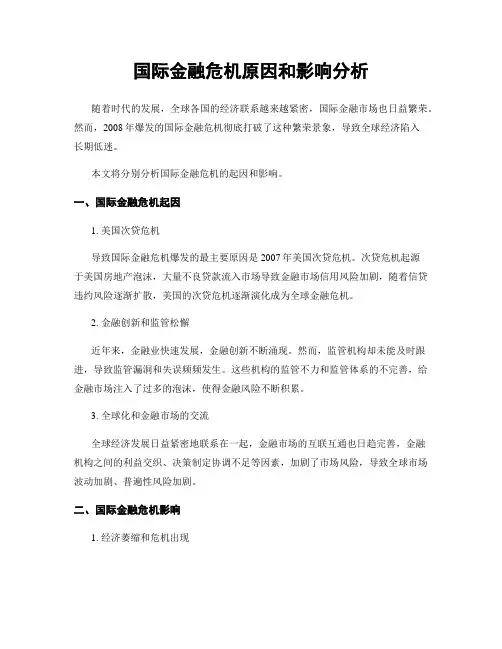
国际金融危机原因和影响分析随着时代的发展,全球各国的经济联系越来越紧密,国际金融市场也日益繁荣。
然而,2008年爆发的国际金融危机彻底打破了这种繁荣景象,导致全球经济陷入长期低迷。
本文将分别分析国际金融危机的起因和影响。
一、国际金融危机起因1. 美国次贷危机导致国际金融危机爆发的最主要原因是2007年美国次贷危机。
次贷危机起源于美国房地产泡沫,大量不良贷款流入市场导致金融市场信用风险加剧,随着信贷违约风险逐渐扩散,美国的次贷危机逐渐演化成为全球金融危机。
2. 金融创新和监管松懈近年来,金融业快速发展,金融创新不断涌现。
然而,监管机构却未能及时跟进,导致监管漏洞和失误频频发生。
这些机构的监管不力和监管体系的不完善,给金融市场注入了过多的泡沫,使得金融风险不断积累。
3. 全球化和金融市场的交流全球经济发展日益紧密地联系在一起,金融市场的互联互通也日趋完善,金融机构之间的利益交织、决策制定协调不足等因素,加剧了市场风险,导致全球市场波动加剧、普遍性风险加剧。
二、国际金融危机影响1. 经济萎缩和危机出现国际金融市场中的危机不仅会对一个国家的金融市场造成影响,也会对整个国际金融市场造成威胁。
金融市场的动荡会给国家的实体经济造成影响,进而导致经济发生萎缩,甚至出现危机。
2. 全球股市暴跌,投资者信心动摇金融市场一旦动荡,股市就会受到极大的影响。
世界各地的投资者也会受到影响,导致股市暴跌,投资者的信心受到极大的动摇。
3. 贸易和投资萎缩金融市场不稳定会影响到贸易和投资。
由于经济发展缓慢,许多公司需要削减成本和裁员,进而进行更谨慎的贸易和投资决策,给全球经济带来了重大的负面影响。
4. 各国政策调整和协调面对国际金融危机的影响,各国政府采取了一系列政策,通过调整资金投放、增强政策协调、加强合作等多种手段应对。
在此过程中,国际金融体系得以逐渐改进,国家间经济合作也得到了加强。
总之,国际金融危机的起因和影响是一个复杂的问题,需要对市场、政策、先进技术等因素进行分析,才能得出更为准确的结论。
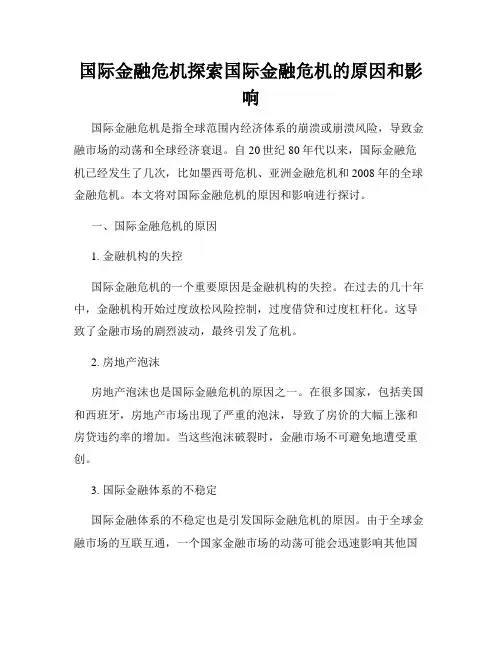
国际金融危机探索国际金融危机的原因和影响国际金融危机是指全球范围内经济体系的崩溃或崩溃风险,导致金融市场的动荡和全球经济衰退。
自20世纪80年代以来,国际金融危机已经发生了几次,比如墨西哥危机、亚洲金融危机和2008年的全球金融危机。
本文将对国际金融危机的原因和影响进行探讨。
一、国际金融危机的原因1. 金融机构的失控国际金融危机的一个重要原因是金融机构的失控。
在过去的几十年中,金融机构开始过度放松风险控制,过度借贷和过度杠杆化。
这导致了金融市场的剧烈波动,最终引发了危机。
2. 房地产泡沫房地产泡沫也是国际金融危机的原因之一。
在很多国家,包括美国和西班牙,房地产市场出现了严重的泡沫,导致了房价的大幅上涨和房贷违约率的增加。
当这些泡沫破裂时,金融市场不可避免地遭受重创。
3. 国际金融体系的不稳定国际金融体系的不稳定也是引发国际金融危机的原因。
由于全球金融市场的互联互通,一个国家金融市场的动荡可能会迅速影响其他国家。
高度复杂的金融衍生品和跨国资本流动加剧了金融系统的脆弱性,当危机来临时,后果不堪设想。
二、国际金融危机的影响1. 经济衰退国际金融危机往往导致全球经济的衰退。
危机期间,企业投资减少,消费者信心下降,出口减少,这些都会导致经济增长的放缓甚至负增长。
例如,2008年的全球金融危机导致了全球范围内的经济衰退,多个国家的GDP出现了负增长。
2. 失业率上升国际金融危机还会导致失业率的上升。
在经济衰退期间,企业为了削减成本,往往会进行大规模裁员。
此外,金融机构的倒闭和经济不景气也会使就业市场更加困难。
因此,国际金融危机的影响往往会导致大量人口的失业。
3. 政府债务危机国际金融危机还会导致政府债务的增加和债务危机的爆发。
在危机期间,政府会采取一系列的财政刺激措施来刺激经济增长,比如降低利率、增加财政支出等。
这些措施会导致政府债务的快速增加,当财政状况无法为这些债务提供充足的支持时,债务危机就可能发生。
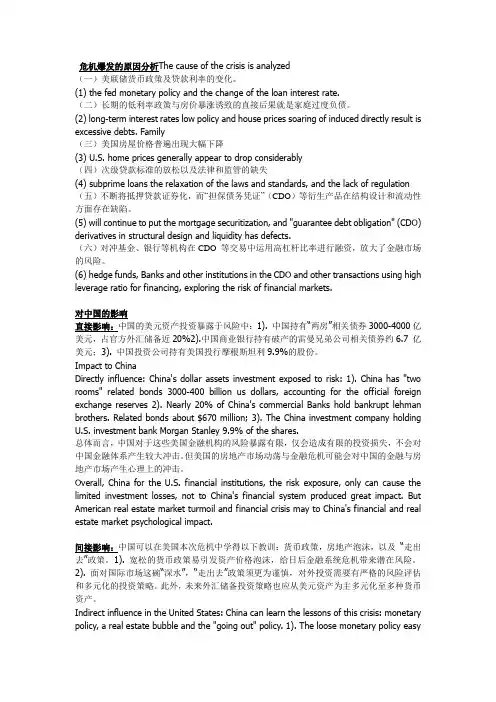
危机爆发的原因分析The cause of the crisis is analyzed(一)美联储货币政策及贷款利率的变化。
(1) the fed monetary policy and the change of the loan interest rate.(二)长期的低利率政策与房价暴涨诱致的直接后果就是家庭过度负债。
(2) long-term interest rates low policy and house prices soaring of induced directly result is excessive debts. Family(三)美国房屋价格普遍出现大幅下降(3) U.S. home prices generally appear to drop considerably(四)次级贷款标准的放松以及法律和监管的缺失(4) subprime loans the relaxation of the laws and standards, and the lack of regulation (五)不断将抵押贷款证券化,而“担保债务凭证”(CDO)等衍生产品在结构设计和流动性方面存在缺陷。
(5) will continue to put the mortgage securitization, and "guarantee debt obligation" (CDO) derivatives in structural design and liquidity has defects.(六)对冲基金、银行等机构在CDO 等交易中运用高杠杆比率进行融资,放大了金融市场的风险。
(6) hedge funds, Banks and other institutions in the CDO and other transactions using high leverage ratio for financing, exploring the risk of financial markets.对中国的影响直接影响:中国的美元资产投资暴露于风险中:1). 中国持有“两房”相关债券3000-4000亿美元,占官方外汇储备近20%2).中国商业银行持有破产的雷曼兄弟公司相关债券约6.7 亿美元;3). 中国投资公司持有美国投行摩根斯坦利9.9%的股份。
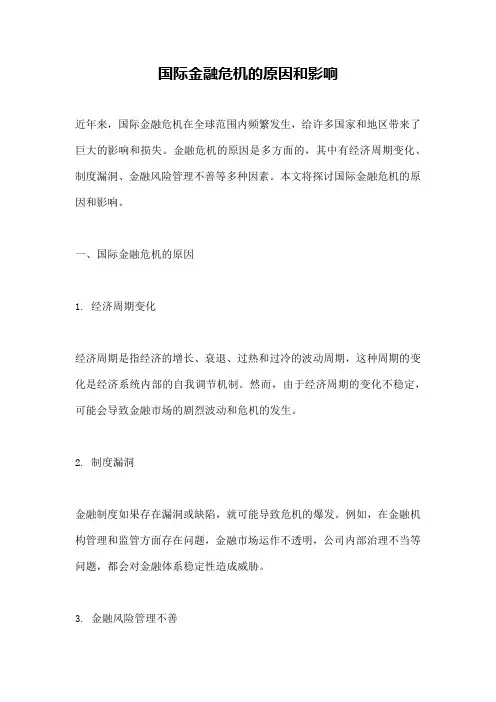
国际金融危机的原因和影响近年来,国际金融危机在全球范围内频繁发生,给许多国家和地区带来了巨大的影响和损失。
金融危机的原因是多方面的,其中有经济周期变化、制度漏洞、金融风险管理不善等多种因素。
本文将探讨国际金融危机的原因和影响。
一、国际金融危机的原因1. 经济周期变化经济周期是指经济的增长、衰退、过热和过冷的波动周期,这种周期的变化是经济系统内部的自我调节机制。
然而,由于经济周期的变化不稳定,可能会导致金融市场的剧烈波动和危机的发生。
2. 制度漏洞金融制度如果存在漏洞或缺陷,就可能导致危机的爆发。
例如,在金融机构管理和监管方面存在问题,金融市场运作不透明,公司内部治理不当等问题,都会对金融体系稳定性造成威胁。
3. 金融风险管理不善金融机构存在的风险管理不善也是导致国际金融危机的重要原因之一。
例如,金融机构存在风险过度集中、风险感知不足以及对市场变化缺乏有效反应等问题,容易导致金融机构出现严重的资产负债风险,从而引发金融危机。
二、国际金融危机的影响1. 严重影响经济增长金融危机往往会引发一系列连锁反应,导致经济萎缩、失业率上升、通货膨胀,严重影响国家的经济增长。
特别是在出口主导型经济体中,金融危机的影响更加明显。
2. 扰乱金融市场运作金融危机时期,市场波动大,金融机构资产负债表构成复杂,投资者风险偏好剧烈波动。
这些特点会扰乱金融市场的正常运作,使各方对金融市场的信心受到打击,进而导致市场崩盘。
3. 加剧国际贸易保护主义金融危机时期,许多国家或地区采取了贸易保护主义的政策,对外实施高额关税和贸易限制措施,以保护本国企业和产业。
这种政策将加剧全球化进程中国际贸易的政治化和地区化。
这也会导致国际贸易体系的不稳定和失衡。
4. 加大国际金融改革力度国际金融危机给国际金融体系敲响了警钟,也激发了各国推进国际金融改革的决心。
对于发达国家而言,改革包括金融机构组织结构的重建、繁琐的监管制度的改进、金融市场体系的完善等。
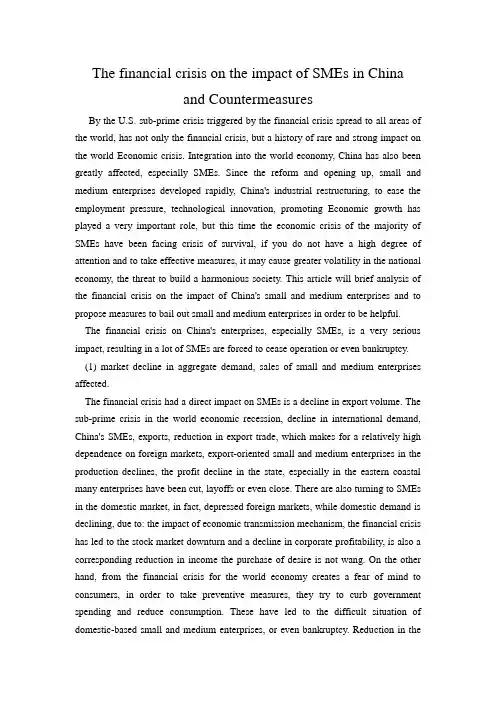
The financial crisis on the impact of SMEs in Chinaand CountermeasuresBy the U.S. sub-prime crisis triggered by the financial crisis spread to all areas of the world, has not only the financial crisis, but a history of rare and strong impact on the world Economic crisis. Integration into the world economy, China has also been greatly affected, especially SMEs. Since the reform and opening up, small and medium enterprises developed rapidly, China's industrial restructuring, to ease the employment pressure, technological innovation, promoting Economic growth has played a very important role, but this time the economic crisis of the majority of SMEs have been facing crisis of survival, if you do not have a high degree of attention and to take effective measures, it may cause greater volatility in the national economy, the threat to build a harmonious society. This article will brief analysis of the financial crisis on the impact of China's small and medium enterprises and to propose measures to bail out small and medium enterprises in order to be helpful. The financial crisis on China's enterprises, especially SMEs, is a very serious impact, resulting in a lot of SMEs are forced to cease operation or even bankruptcy. (1) market decline in aggregate demand, sales of small and medium enterprises affected.The financial crisis had a direct impact on SMEs is a decline in export volume. The sub-prime crisis in the world economic recession, decline in international demand, China's SMEs, exports, reduction in export trade, which makes for a relatively high dependence on foreign markets, export-oriented small and medium enterprises in the production declines, the profit decline in the state, especially in the eastern coastal many enterprises have been cut, layoffs or even close. There are also turning to SMEs in the domestic market, in fact, depressed foreign markets, while domestic demand is declining, due to: the impact of economic transmission mechanism, the financial crisis has led to the stock market downturn and a decline in corporate profitability, is also a corresponding reduction in income the purchase of desire is not wang. On the other hand, from the financial crisis for the world economy creates a fear of mind to consumers, in order to take preventive measures, they try to curb government spending and reduce consumption. These have led to the difficult situation of domestic-based small and medium enterprises, or even bankruptcy. Reduction in theface of market share, increasing competition among enterprises on the market the product even more serious oversupply of lower prices, corporate profit margins shrink, survival more difficult.(2) The increase in cost, small and medium enterprises be further squeezed profit margins.First of all, in recent years, raw materials and energy prices overall rose substantially higher prices for agricultural products, leading to increased production costs of SMEs; Second, the new 'Labor Contract Law' demand for workers on foot 3 business insurance, payment overtime, which is no doubt regulated employment system, and improving the income of the workers and safeguard the basic rights of workers, but on the other hand, this will also increase their labor costs and make Enterprise Management more difficult; again, due to environmental degradation, governments at all levels also increased environmental management efforts to require companies waste water treatment, exhaust gas recycling purification, for non-compliance emissions, polluting enterprises to adopt a deadline for correction according to law, and other measures, which also forced the The costs for enterprises to improve the environment. At the same time as the prices of production factors, enterprises pay for the cost of land use is also increasing.(3) SME financing difficulties.In recent years, SMEs widespread system is not sound Financial Management was not standardized, low mortgage guarantee agencies, Information opaque, such phenomena as lack of credit, resulting in difficulties in obtaining bank loans for SMEs, financing channels less difficult, insufficient funds, which SME Development has been troubled by a major 'bottleneck'. With the advent of the financial crisis, this issue become more prominent. In the context of world economic recession, SMEs operating difficulties, increased credit risk, banks in order to reduce the risk of their own to raise the threshold for lending to SMEs, lending amount is declining, which makes it more difficult for the financing of SMEs. Although countries have introduced financial institutions to increase credit support for SMEs policy, but because of the credit market Information asymmetry caused by the 'adverse selection' and the moral hazard problem would make the bank is limited enforcement of these policies. In addition, the advent of the financial crisis, the decline in aggregate demand, domestic and international markets, raw materials and energy costs, corporate profit margins narrow,with the result of internal financing capacity of small and medium enterprises also dropped significantly.Small and medium enterprises to promote China's economic development has an important role in helping small and medium enterprises out of difficulty, the Government is duty-bound, to come from the following aspects:First of all, to improve the financing environment for SMEs to increase policy support. Local governments can finance through the creation of a special fund to develop small business loan interest subsidy system; the establishment of SME credit risks and increase the compensation funds, to increase loans to SMEs financial institutions to give appropriate compensation; perfect the security system and establish a security risk compensation mechanism, to reduce Small secured loan interest rate, increase the amount small secured loans; got the right to make good use private capital to expand the financing channels; to strengthen and improve the services for SMEs, to establish and improve social service system for SMEs. Second, relevant government departments should guide scientific Research institutes, colleges and universities with the SMEs 'production and research' combination of technological Innovation for SMEs to provide credit support to facilitate the transformation of scientific and technological achievements. Government policy is helping SMEs to cope with the financial crisis, external causes, the SME's own forces are internal, according to philosophical principles we can see that external and internal factors must play a role, but play a decisive role in internal and external causes by internal factors play a role. Therefore, SMEs can not simply rely on the Government introduced a large number of policies to deal with the financial crisis, SMEs play a decisive role in the survival or the enterprise's own strength, SMEs must take measures on their own, actively respond to the crisis. (1) reaffirm our confidence.To overcome the financial crisis, should first of all confidence, clarify development ideas. As Premier Wen put it, before the crisis, confidence is more important than gold and currency, confidence is a source of strength to overcome the crisis.(2) seize the opportunity.First of all, use good policy. In order to maintain rapid and sound economic development, expanding domestic demand, the Government has stepped up its efforts to support SMEs in 2008, since the state has adopted a series of policies conducive tothe development of SMEs. If the mitigation aspects of SME financing difficulties, encouraging financial institutions to steadily increase the proportion of SME lending and the recognition of the legalization of private lending, etc.; in improving the financing environment, the PBOC promulgated the 'on further improvement of the views of financial services for SMEs' and 'on strengthening and improving the guidance of financial services for SMEs' and so on; in expanding domestic demand, encourage transformation and upgrading of processing trade enterprises and stability of capital markets. Make good use of these policies will help small and medium enterprises out of difficulties. Reposted elsewhere in the paper for free download Second, to attract talent. Financial crisis occurred in developed countries have laid off a number of large enterprises, which for our small and medium enterprises to attract foreign high-end talents and provide opportunities for overseas students; the same time, the financial turmoil on China's trade, finance and other industries affected relatively large, many of these industries enterprises are lower, and layoffs or bankruptcy, some or all of these enterprises need to re-career personnel, employment pressures, which for our small and medium enterprises to introduce low-cost, high-level managerial talent and financial talent to create opportunities. SMEs should seize this opportunity, reserve personnel, in order to lay a solid foundation for future development.Again, within the framework of a global industrial restructuring opportunities. Europe and the United States and other developed economies affected by financial crisis relatively large, in order to cushion the slump in the domestic economy against the adverse effects of the manufacturing sector, the manufacturing sector in these countries is bound to transfer to developing countries, for China to become the world's largest manufacturing base with a come to a historic opportunity for development. China's small and medium enterprises should seize this opportunity to actively respond to and seek more funds intermediation, merger or acquisition of foreign scientific Research institutions, the upstream raw material supply enterprises and downstream product sales business, efforts to improve the technological content of products, reduce production costs, increase its global market share of sales and enhance China become the world 'manufacturing hub' status.Finally, the industrial upgrading opportunities. The financial crisis, labor-intensive, management is poor, the net production of low value-added processing of primaryproducts or production-oriented enterprises be a major shock, facing the threat of closing or closed down, which forced some enterprises to strengthen management and technical innovation, to upgrade the Industry structure of level, taking product upgrading, winning by quality intensive type business model. At the same time, countries to enhance high-tech products to deep processing of agricultural products as raw materials for export tax rebate rate, reduced or eliminated coal, steel and other resources of value-added products is not high, the export tax rebate rate, which also forced a number of primary products processing enterprises the positive development of production of high-tech products, accelerate industrial restructuring and upgrading, upgrade the structure of export products and expand exports of hi-tech products and strive to enjoy the benefits of the export tax rebate policy.(3) strengthening internal management and enterprises for independent innovation. First of all, we should strengthen management and improve operational efficiency. May take the following specific measures: to retain the best employees, enhance the exchange of ordinary employees, motivate and keep employees motivated, in-house to create a strong cohesive force, improve production efficiency; strengthen their internal management, and build an efficient organization structure, cutting management layers and links, and lower administrative costs; the introduction of specialized production, reduce operating costs of production in order to save money; right to dispose of idle assets to reduce asset loss, but also increase the capital reserves. Secondly, we must increase R & D investment, foster innovation. Production skills on staff training and training to develop staff's sense of Innovation and the establishment of innovative mechanisms to motivate staff, encourage staff to carry out technological innovations, forming their own unique core technology; the use of new Technology Research and development of new products and promote upgrading of products and take the brand development path, to improve the visibility of companies; on service innovation, build first-class service system and improve the corporate reputation.(4) make full use of the Internet, to establish a suitable model of network marketing.With the widespread use of the Internet, people in online shopping has become a fashion, which for the network to create the conditions for the emergence of marketing. Internet marketing, low cost, quick, is to boost sales in an effective way. SMEs should be based on characteristics of their products, customer demand forPopulation characteristics, to establish a suitable model of the enterprise's network marketing.(5) SME joint between horizontal or vertical will help enhance the competitiveness of enterprises. SMEs, due to management, technology, capital and so there are more disadvantages of going it alone is difficult to compete too large enterprises, so in order to improve competitiveness and enhance strength, producing the same or similar products, enterprises and enterprises upstream and downstream of the , are all can be horizontal or vertical, so that is conducive to the formation of economies of scale, lower transaction costs, reduce management costs and production costs, improve efficiency, avoid price wars and malicious competition; but also help to improve operational capability of enterprises, financing capability, science and Technology Innovation ability and management level, enhance their ability to withstand the crisis. In the economic globalization, China will inevitably be drawn into the financial crisis, in which Chinese SMEs have been hit is quite large. SMEs in order to successfully tide over the difficulties, in addition to helping the government, SMEs themselves also need to strengthen confidence, seize opportunities, improve enterprise capability of independent innovation and establish an appropriate network Marketing model lateral vertically integrated companies, only to take these measures will be useful in the context of the financial crisis to survive and develop, can we remain invincible in the fierce competition in order to achieve the post-crisis grow.References[1] Wu Qun: 'The global financial crisis environment for SME development Analysis'[J];' Nanjing Institute of Politics Journal of '2008 (6): 43.[2] Zhanbi English: 'on the global financial crisis on the impact of private enterprisesand coping thinking' [J]; 'Central Institute of Socialism Journal of '2009 (2): 77. [3] Feng-Ying Zhang: 'Financial crisis SME Marketing Strategy' [J]; 'academic paperson '2009 (13): 15. Reposted elsewhere in the paper for free download金融危机中国的中小企业的影响及对策由美国次贷危机引发并蔓延到世界所有地区的金融危机,不仅是金融危机,更是一种世界历史罕见的强烈影响和经济危机。

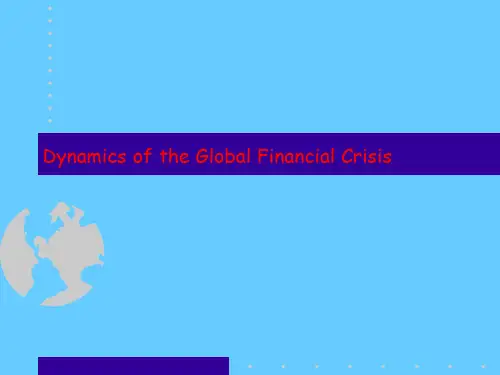
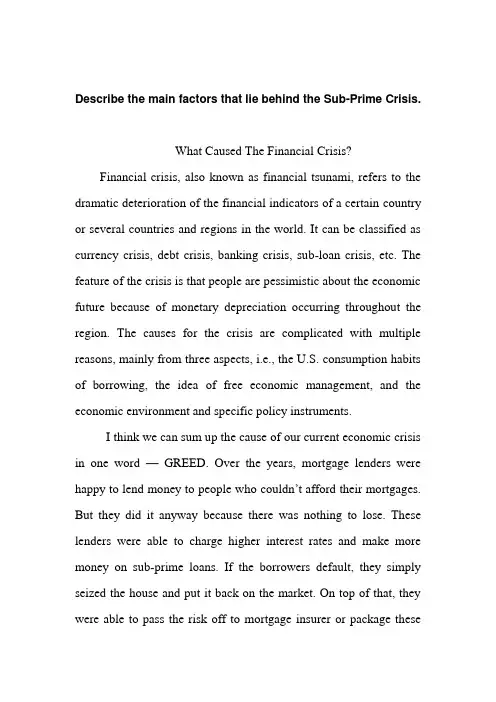
Describe the main factors that lie behind the Sub-Prime Crisis.What Caused The Financial Crisis?Financial crisis, also known as financial tsunami, refers to the dramatic deterioration of the financial indicators of a certain country or several countries and regions in the world. It can be classified as currency crisis, debt crisis, banking crisis, sub-loan crisis, etc. The feature of the crisis is that people are pessimistic about the economic future because of monetary depreciation occurring throughout the region. The causes for the crisis are complicated with multiple reasons, mainly from three aspects, i.e., the U.S. consumption habits of borrowing, the idea of free economic management, and the economic environment and specific policy instruments.I think we can sum up the cause of our current economic crisis in one word —GREED. Over the years, mortgage lenders were happy to lend money to people who couldn’t afford their mortgages. But they did it anyway because there was nothing to lose. These lenders were able to charge higher interest rates and make more money on sub-prime loans. If the borrowers default, they simply seized the house and put it back on the market. On top of that, they were able to pass the risk off to mortgage insurer or package thesemortgages as mortgage-backed securities. Easy money!and what went wrong with our financial system? The whole thing was one big scheme. Everything was great when houses were selling like hot cakes and their values go up every month. Lenders made it easier to borrow money, and the higher demand drove up house values. Higher house values means that lenders could lend out even bigger mortgages, and it also gave lenders some protection against foreclosures. All of this translates into more money for the lenders, insurers, and investors. Unfortunately, many borrowers got slammed when their adjustable mortgage finally adjusted. When too many of them couldn’t afford to make their payments, it causes these lenders to suffer from liquidity issue and to sit on more foreclosures than they could sell. Mortgage-backed securities became more risky and worth less causing investment firms like Lehman Brothers to suffer. Moreover, insurers like AIG who insured these bad mortgages also got in trouble.The scheme worked well, but it reverses course and is now coming back to hurt everyone with a vengeance.The subprime mortgage crisis is an ongoing financial crisis characterized by contracted liquidity in global credit markets and banking systems triggered by the failure of mortgage companies, investment firms and government sponsored enterprises which hadinvested heavily in subprime mortgages. The crisis, which has roots in the closing years of the 20th century but has become more apparent throughout 2007 and 2008, has passed through various stages exposing pervasive weaknesses in the global financial system and regulatory framework.The crisis began with the bursting of the United States housing bubble and high default rates on supbrise and adjustable rate mortgages (ARM), beginning in approximately 2005–2006. For a number of years prior to that, declining lending standards, an increase in loan incentives such as easy initial terms, and a long-term trend of rising housing prices had encouraged borrowers to assume difficult mortgages in the belief they would be able to quickly refinance at more favorable terms. However, once interest rates began to rise and housing prices started to drop moderately in 2006–2007 in many parts of the U.S., refinancing became more difficult. Defaults and foreclosure activity increased dramatically as easy initial terms expired, home prices failed to go up as anticipated, and ARM interest rates reset higher. Foreclosures accelerated in the United States in late 2006 and triggered a global financial crisis through 2007 and 2008. During 2007, nearly 1.3 million U.S. housing properties were subject to foreclosure activity, up 79% from2006.Major banks and other financial institutions around the world have reported losses of approximately US$435 billion as of 17 July 2008 The liquidity concerns drove central banks around the world to take action to provide funds to member banks to encourage lending to worthy borrowers and to restore faith in the commercial paper markets. The U.S. government also bailed out key financial institutions, assuming significant additional financial commitments.是什么造成了金融危机?金融危机,又称金融风暴,是指一个国家或几个国家与地区的金融指标的急剧恶化。
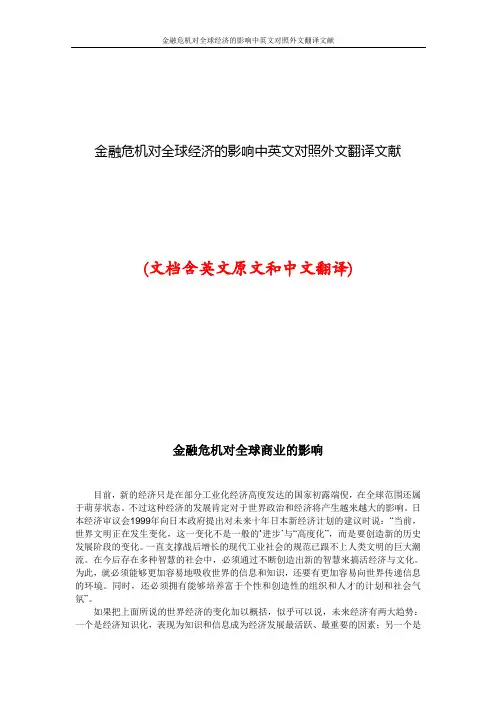
金融危机对全球经济的影响中英文对照外文翻译文献(文档含英文原文和中文翻译)金融危机对全球商业的影响目前,新的经济只是在部分工业化经济高度发达的国家初露端倪,在全球范围还属于萌芽状态。
不过这种经济的发展肯定对于世界政治和经济将产生越来越大的影响。
日本经济审议会1999年向日本政府提出对未来十年日本新经济计划的建议时说:“当前,世界文明正在发生变化,这一变化不是一般的‘进步’与“高度化”,而是要创造新的历史发展阶段的变化。
一直支撑战后增长的现代工业社会的规范已跟不上人类文明的巨大潮流。
在今后存在多种智慧的社会中,必须通过不断创造出新的智慧来搞活经济与文化。
为此,就必须能够更加容易地吸收世界的信息和知识,还要有更加容易向世界传递信息的环境。
同时,还必须拥有能够培养富于个性和创造性的组织和人才的计划和社会气氛”。
如果把上面所说的世界经济的变化加以概括,似乎可以说,未来经济有两大趋势:一个是经济知识化,表现为知识和信息成为经济发展最活跃、最重要的因素;另一个是经济全球化,表现为商品、劳务、资本、技术和人才在全球流动的加速。
这两大趋势相互联系、互相影响。
也可以说,新的经济将是以知识与技术创新为基础,以全球为市场的时代。
它将促使各国的增长模式、产业构成、经济体制、社会结构、教育制度、文化取向等产生深刻的变化,也将对各国的对内、对外政策提出新课题。
三、经济全球化的大趋势及其两重性经济全球化的发端似可溯源到二次世界大战后期布雷顿森林体制的创建。
世界银行、国际货币基金组织和关贸总协定三大机构的建立与发展,给全球金融、贸易与投资活动以极大的推动。
美元与黄金挂钩使美元成为国际流通与储备的手段,首先便利了美国企业向全球的拓展。
不过,冷战时期两个世界市场的划分又使经济全球化受到一定限制。
冷战结束后,经济全球化得到进一步发展。
主要有两股力量推动:一股力量是信息技术革命和高新技术成长的大大促进了商品、劳务、资本、人才、技术的全球交流。
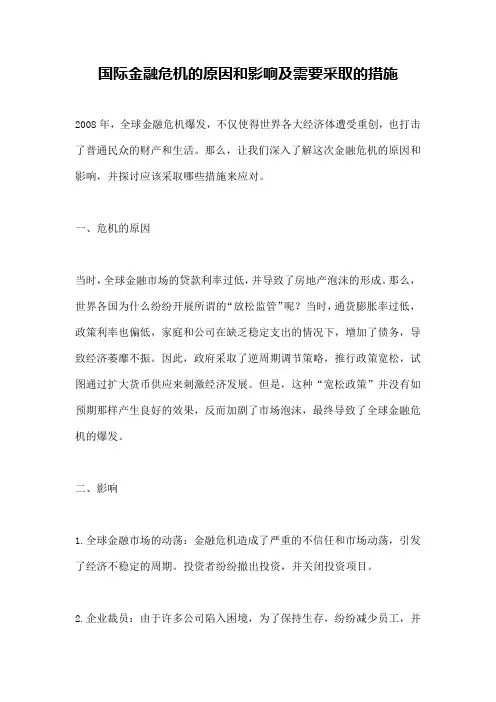
国际金融危机的原因和影响及需要采取的措施2008年,全球金融危机爆发,不仅使得世界各大经济体遭受重创,也打击了普通民众的财产和生活。
那么,让我们深入了解这次金融危机的原因和影响,并探讨应该采取哪些措施来应对。
一、危机的原因当时,全球金融市场的贷款利率过低,并导致了房地产泡沫的形成。
那么,世界各国为什么纷纷开展所谓的“放松监管”呢?当时,通货膨胀率过低,政策利率也偏低,家庭和公司在缺乏稳定支出的情况下,增加了债务,导致经济萎靡不振。
因此,政府采取了逆周期调节策略,推行政策宽松,试图通过扩大货币供应来刺激经济发展。
但是,这种“宽松政策”并没有如预期那样产生良好的效果,反而加剧了市场泡沫,最终导致了全球金融危机的爆发。
二、影响1.全球金融市场的动荡:金融危机造成了严重的不信任和市场动荡,引发了经济不稳定的周期。
投资者纷纷撤出投资,并关闭投资项目。
2.企业裁员:由于许多公司陷入困境,为了保持生存,纷纷减少员工,并加强成本控制。
这些裁员事件造成的影响时间长,并持续影响家庭、社区和公司的财政组织能力。
3.财政危机:政府为了应对危机,不得不拆迁政府债务大幅增加,甚至有些国家无法偿还债务。
在危机的影响下,很多社会福利项目也遭受了打击,并大幅缩减或取消。
此外,这些政策还对公共资源和对社区服务实施限制。
三、应采取的措施针对金融危机的严重后果,政府和金融机构采取了一系列应对措施。
1.扩大财政赤字:国家采取了扩大财政赤字的措施,并提供更多的资金支持,以便帮助那些企业度过金融危机,缓解个人和家庭的财政压力。
2.实施货币政策:由于银行缺乏流动性,央行决定增加贷款额度,并降低政策利率,以刺激金融市场的活力,并扩大货币供应,以支持实业经济。
3.加强金融监管:为了避免市场过热,政府和监管机构加强金融监管,完善法律体系,减少金融市场的不稳定性。
总之,全球金融危机的爆发让我们认识到了金融市场的重要性和必要性,也让我们了解到政府和金融机构的一些应对措施。
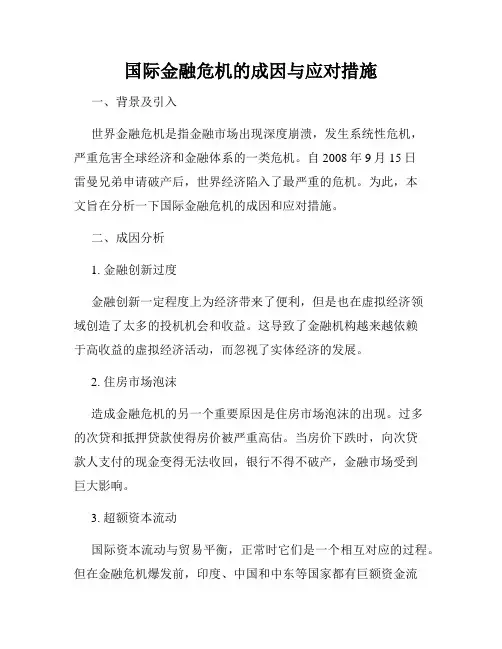
国际金融危机的成因与应对措施一、背景及引入世界金融危机是指金融市场出现深度崩溃,发生系统性危机,严重危害全球经济和金融体系的一类危机。
自2008年9月15日雷曼兄弟申请破产后,世界经济陷入了最严重的危机。
为此,本文旨在分析一下国际金融危机的成因和应对措施。
二、成因分析1. 金融创新过度金融创新一定程度上为经济带来了便利,但是也在虚拟经济领域创造了太多的投机机会和收益。
这导致了金融机构越来越依赖于高收益的虚拟经济活动,而忽视了实体经济的发展。
2. 住房市场泡沫造成金融危机的另一个重要原因是住房市场泡沫的出现。
过多的次贷和抵押贷款使得房价被严重高估。
当房价下跌时,向次贷款人支付的现金变得无法收回,银行不得不破产,金融市场受到巨大影响。
3. 超额资本流动国际资本流动与贸易平衡,正常时它们是一个相互对应的过程。
但在金融危机爆发前,印度、中国和中东等国家都有巨额资金流入美国市场。
美国央行也有大量的机构投资产品,保险公司和股票投资基金购买大量不良债务和投资产品,这使得财务风险增加。
三、应对措施1. 加强金融监管加强对金融机构的监管刻不容缓。
制定出行之有效的监管机制和规则,严格按照这些制度来按照金融机构的业务操作,切实保证系统安全和金融体系的发展。
2. 调整经济结构国家需要调整经济结构,通过改变实体经济的发展方式来减少对虚拟经济的依赖,避免金融创新过度和自负风险。
3. 加强国际合作在国际合作方面,需要国际社会加强合作,共同制定金融风险监管的原则和标准,认真执行金融危机防范预警系统,发挥国际金融机构的作用,推动全球金融体系落实监管机制。
四、结论综上所述,国际金融危机是由多种原因造成的,为了预防下一次金融危机的出现,我们需要加强金融监管,调整经济结构和加强国际合作。
只有这样才能营造良好的金融环境,为国家和人民提供一个更加健康的金融体系。
金融危机的原因英文第一篇:金融危机的原因英文美国金融危机原因(B)The recent upheaval in the financial sector has some people in a panic, most people bewildered, and others busy aiming their pointer fingers at whomever they think is guilty of doing something that contributed to this problem.The presidential candidates are in the latter category.They aren’t quite sure what to do or what to say, but that doesn’t stop them from saying something, anyway.John McCain made a decisive statement, attempting to show leadership, but his statement was not a very smart one.Barack Obama, by contrast, simply blamed Republicans.Few things are as simple as politicians make them seem in an election year.Political candidates succeed by issuing pointed statements that are easy to understand and that connect with voters;truth and accuracy are not the primary concerns.The important thing right now is to figure out whatactually happened in the financial sector, and fix things so it can’t happen again.We must ignore thetremendous amount of speculation about what “might” happen, and the doom andgloomsoothsayerswho tell us that the sky is falling or that the end of the world drawethnye.Because of its complexity the current financial situation invites simple political messages that connect with voters;it does notlenditself to full explanations that illuminate.So, when Sen.Obama says that “it’s theRepublicans’ fault,” he is expressing a simple idea that a lot of people buy into, but doesn’t explain anything.It is a sillyoversimplificationunworthy of a man who would bePresident.It appeals to emotional prejudices and ignores inconvenient realities, and most important of all, it is just plain wrong.When Sen.McCain suggested that Securities and Exchange Commission head Christopher Cox didn’t do his job, and if he were president he would fire Mr.Cox, the Senator didn’t offer specifics.We’ll know moreabout Mr.Cox’s role as time passes and we learn moreof the details, and can then judge if Mr.McC ain’s simple message to voters about firing Chris Cox was a proper evaluation of the situation.Sen.Obama described the currentagonyas “the most serious financial crisis since the GreatDepression,” ignoring all the recessions since then, even the ones in the 80s and the one following the 9-11 attacks, botharguablymore serious crises.Of course, it remains to be seen just how serious this problem will ultimately be, but given Mr.Obama’sabysmalunderstanding of things economic, we would do well to take hisprognosticationswith agrainof salt.The root of this problem is the housing market’ssubprime loan crisis.A subprime loan is a loan made to someone who under normal circumstances would not qualify for a loan, based upon their income and their ability to make payments.Thatbegthe question: Why would a bank make a loan to someone it believes is unable to make the payments?The Community Reinvestment Act(CRA)was given life during the Carter administration, andempowersfour federal financial supervisory agencies to oversee the performance of financial institutions in meeting the credit needs of their entire community, including low-and moderate-income neighborhoods.Whenever an institution wants to make virtually any change in its businessoperation, such asmergingor opening up a new branch, or getting into a new line of business, it must first prove toregulatorsat it has made ample loans to the government's preferred borrowers, those in low-and middle-income neighborhoods who normally would not qualify for a loan.Lenders with low ratings can befined by the government.The Carter administration used tax dollars to fund numerous ”community groups" that helped the governmentenforcethe CRA by filing petitionsagainst banks whose “cooperativeness” didn’t measure up, and sometimes stopping their efforts to expand their operations.Banks responded by giving money tothe community groups and by making more loans.One of those organizations was the Association ofCommunity Organizations for Reform Now(ACORN).An active associate of ACORN in the 90s was a young public-interestattorneynamed Barack Obama.So, starting in 1977 the federal government began “encouraging”—perhaps “strong-arming” is a more accurateterm—banks to make loans to people to whom they normally would not make a loan, and in 1995 the Clinton administration pushed throughrevisions to the CRA that substantially increased the number and amount of these loans.All of the bad loans weren’t caused by the CRA, ofcourse, but billions of dollars in CRA loans did go bad, as should have been expected.When Fannie Mae andFreddie Mac came along and made it possible for banks to escape the risk associated with theseill-advised loans, conditions were just right for a large portion of the banking industry, even institutions that did not fall under the CRA, to become involvedin making loans tounqualified borrowers, and banks participated in big numbers.The federal government’s fingerprints are all over this crisis, and the Democrats who are today so righteously indignantand blaming the administration are at least as guilty as the Republicans.第二篇:金融危机原因分析2008年国际金融危机产生原因分析10090423 10商务英语1班王舒悦【摘要】2008年美国发生的金融危机迅速的席卷全球,演变为全球性金融危机。
试析国际金融危机的成因及我国的应对策略【摘要】随着全球经济一体化趋势的日渐明显,资本的国际流动和国际资本市场对于中国经济发展的重要性日益突出,但与之相伴的金融风险也越来越大。
如何应对这种挑战,趋利避害是摆在中国金融界和政府面前的一项重要课题。
本文在分析金融危机成因和后果的基础上提出了一系列的应对策略。
【Abstract】With the trend of the global incorporate economy coming obvious day by day, the importance of the internal capital stream and internal capital market to the development of Chinese economy is more and more prominent, but the financial risk together with it comes bigger and bigger. How to answer this kind of challenge and to tend to the profit and avoid the harm is one main subject which is placed in front of our Chinese financial field and government. In this article, the writer has brought forward some strategies for answering it after having analyzed the reason and result of the financial risk.【Keywords】International finance crisisCause of formationAnswering strategy一场震惊世界的金融风暴席卷而来,全球正面临自上世纪30年代“大萧条”以来最严重的金融危机。
国际金融危机的成因及其对世界经济的影响近年来,我们不难发现,国际金融危机风露渐浓,其危害性逐渐深入人心,对整个世界经济造成了极其严重的影响。
本文旨在探究国际金融危机的成因及其对世界经济的影响。
一、国际金融危机的成因1.金融市场过度放松监管,风险暴露在过去的几年中,由于金融市场监管放松,金融机构贷款过度扩张,众多的财务衍生品的出现以及其他金融创新的应用,金融系统成为了风险的重灾区。
当风险最终被暴露时,金融危机也随之而来。
2.过度信任市场全球投资者普遍过度信任市场的有效性,金融危机前的一段时间,金融市场表现得非常强劲,诱使投资者获得了极大的利益。
但是市场这种虚假的繁荣背后,却诱发了金融繁荣的最大风险。
3.过度消费金融繁荣还风马牛不相及,推动了消费支出的上升。
这种繁荣不断地吸引着欠缺稳定工作的人们借款用于消费。
二、国际金融危机对世界经济的影响1.贸易订单下降金融危机导致全球贸易订单大幅下降,且由于出口国和出口商都面临金融问题,贸易订单往往被扼杀在摇篮里。
这种情形导致全球经济开始陷入了一个周期性的衰退,加重了金融危机对世界经济的影响。
2.股票市场下跌金融危机引发了全球股票市场的剧烈波动,导致股票市场价格急剧下跌,风险和利润被极大地降低。
短期内,大量经济活动的积极性都随之下降,股票市场的下跌进一步加重了金融危机的影响。
3.银行体系崩溃金融危机也导致全球银行体系的崩溃。
银行债券和股票的价值急剧下跌,银行体系的资产遭到了毁灭性的打击。
这进一步限制了银行贷款的数量和质量,并极大地妨碍了整个经济的复苏。
4.市场恢复时间长长期以来,市场的通辽特征是其稳定性,即使在经济萧条的时候,市场也可以在较短时间内从衰退中恢复过来。
然而,在金融危机中,市场恢复的时间被极大地拉长了。
这样糟糕的局面让经济对市场相当失去了信心,将进一步限制经济活动和贸易活动。
三、结论到目前为止,我们已经对国际金融危机的成因以及对世界经济的影响有了足够的了解。
全球危机的影响成因(The causes of the global crisis The concept of the global financial crisis: the rapid deterioration of all or most of the financial indicators in the financial sector, so as to affect the stability and development of the relevant countries, regions and even the world economy. Including the global currency crisis, the global debt crisis, the global banking crisis.Causes of the global financial crisisUnder the background of economic globalization, the imbalance of international economy will lead to the re allocation of international capital in the global scope. In a sense, the imbalance of international economy and the defects of the international monetary system are the preconditions for the outbreak of the financial crisis, and the attack of the international hot money is the realization condition of the outbreak of the financial crisis. The commoncauses of the two international financial crises in 1997 and 2008:One is the integration of the global economy;Two is the inherent instability of international financial markets;Three is the excess liquidity and high level of capital flow. That is, under the modern monetary credit mechanism, the asymmetry of information leads to the crisis. As long as the modern market economy exists, the monetary credit mechanism inherent in the market economymaylead to the financial crisis.The financial crisis is caused by external factors orinternal factors, and there are two opposing views in the academic circle: conspiracy theory and law theory. Conspiracy theory holds that the financial crisis is caused by premeditated and planned attacks on the economy, and is caused by external causes, especially after the financial crisis in Southeast asia. The theory of law holds that the financial crisis is the law of the economy itself, and is caused by internal causes. The three generation of financial crisis theory basically acknowledges the law theory. With the improvement of financial supervision, a country for supervision or control problems caused decreases the probability of financial crisis; and with the growing trend of economic globalization, modern financial crisis basically showed an imbalance in international economic conditions, the use of national capital international monetary system distorted in the interests of the drive to regional finance the outbreak of the crisis, which in essence, nature and causes of the financial crisis has changed.First, the imbalance of international economyHuang Xiaolong (2007) [1 believes that the imbalance of international payments leads to the imbalance of the international monetary system, the virtual economy leads to excess liquidity, which leads to the global economic imbalances and financial crisis. Huang Xiaolong is home to complete from the external factor of the financial crisis, but fundamentally the root causes of global economic imbalances should be the imbalance of the real economy, the imbalance of international payments is unbalanced realeconomy phenomenon, unbalanced real economyleads to currency of international capital flows,international capital flows lead to expansion of the virtual economy and the depression. The formation of a shortage of liquidity, can eventually lead to financial crisis. Therefore, the imbalance of the global real economy is the necessary condition for the financial crisis, and theliquidity shortage caused by the virtual economy is the sufficient condition of the financial crisis.Throughout the history of the financial crisis, the financial crisis is always accompanied by regional or global economic imbalances. The European financial crisis in 1992, from the unification of Germany and the rapid economic development of Germany, broke the economic balance between Germany and the United States, and between Germanyand other European countries. Japan in 1990 was also because of the economic balance between the United States and Japan was broken, in the role of the financial crisis, to achieve a new economic equilibrium.Regional or global economic imbalances will lead to the reallocation of international capital within a certain range. Under the background of regional economic integration and economic globalization, the influence of a country's macro policy may be regional or global. Whena country of a stronger economy will attract international capital inflows to the country, the result is also some of the country's capital outflows, whencapital outflows will occur to a certainextent, the shortage of liquidity, the financial crisis is changing from possibility to necessity. The signal for this change is the high interest rate policy of big countries, or the strong monetary policy of big powers. But for a small country in terms of economy, a stronger economy, will attract internationalcapital inflows, when the number of international capital inflows, the country's real economyto absorb the international capital is saturated, the international capital will be the integration of virtual economy and the country's economic bubble, when the virtual economy and real economy serious divergence,The rapid retreat of international capital led to the small country from the excess liquidity to the liquidity crunch, resulting in the outbreak of the financial crisis.From the international economic imbalance leads to the formation of the path can be seen in the financial crisis, international economic imbalances through the balance of payments, international payments imbalances and adjustment through the international monetary system, if you have a perfect and effective international monetary system, so can avoid the mandatory international economic and disruptive adjustment, that is to say can be avoided the financial crisis, but the reality of the international monetary system is controlled by great powers, and international economic imbalances will be further enlarged and distorted.Two. Distortion of the international monetary systemXu Mingqi is a scholar who has earlier attributed the financial crisis of developing countries to the inherent defects of the international monetary system. Xu Mingqi (1999) [2] that one is wandering in order to maintain the status quo and weakening of reform the international monetary system; on the other hand is developing in the international trade, investment and debtin a weak position; dual constraints of developing countries have to swallow a bitter financial crisis, and thus escape the inherent defects of the existing international the monetary system of the blame. It is said that the international monetary system follows the basic principles and concepts of the Bretton Woods system in the mediation of international balance of payments, and countries in the formulation of monetary policy coordination in international economic imbalances has lost the original order and discipline, and now the international economic imbalance is now the international monetary system enlarged, exacerbated. The collapse of the Bretton Woodssystem, the existing international monetary system is a loose international monetary system, although the role of the euro and the yen in the international monetary system has gradually increased, however, reserve currency diversification can not effectively solve the "Triffin Dilemma", only contradiction that reserve currency diversification, is a national currency in the international the identity of the same currency. In the case of the dollar, the dollar's value adjustment is achieved through the adjustment of the dollar interest rate. The fed in the formulation of U.S. interest rates, can not take into account the dollar peg to the dollar as a reserve or country (region) macroeconomic situation, so when the dollar interest rate adjustment, often in other economies, especially theUnited States and relatively close economic ties or currency pegged countries and regions caused by the impact of [2].Can be seen from the above analysis, now the international monetary system retains the original ideas and principles of the international monetary system, but lost the original order and discipline, strong economies can use this system on the financial crisis and obtain more profits, and should not assume too much responsibility.Three, international hot money attacksThe imbalance of international economy is the precondition of the financial crisis, and the imperfect international monetary system will aggravate the imbalance of international economy. However, the financial crisis is caused by the international floating capital.After the collapse of Bretton Woods system, the financial crisis can not be separated from the attack of international hot money. As we all know, the scale of international hot money is large, and it has the ability to influence and shorten the financial cycle of the countries under attack. When the international hot money enters the attacked country, it will affect the interest rate and exchange rate change of a country, thus speeding up the transformation of thefinancial market from rational development to irrational prosperity [3].According to the psychological expectation self actualization principle of the financial market, the international hot money has premeditated entry and retreat, which will lead tothe collapse of the financial market. International capital skillfully use financial derivatives to earn high profits in the period of financial prosperity, can also use the financial crisis to earn high profits or capital acquisition quality crisis of the country, and then control the economic lifeline of the country was attacked. In 1992 the European financial crisis, Soros through the wayof obtaining 1: 20 margin lending, in just one month's time, by selling the equivalent of $7billion, equivalent to $6 billion to buy Mark, forcing the substantial depreciation of the pound, the repayment of loans after more than $1 billion 500 million [4].Hedge fund investment strategy is also constantly enriched, from the initial "short selling + leverage" strategy (market neutral fund),It has developed into a single strategy (including arbitrage, direction, event driven, etc.), Multi Strategy (including emerging markets, mergers and acquisitions, etc.), fund and other investment strategies. Its riskcharacteristics show a variety of trends, both highrisk, high income macro hedge funds, but also low-risk, but relatively stable market neutral fund.Typical features before the financial crisis:First, the economy has maintained high growth for many years; Two is a large inflow of external funds;Three is the rapid growth of domestic credit;Four is the general over investment;Five is the rapid rise in asset prices such as stocks and real estate;Six, the trade deficit continues to deteriorate;fundsSeven, the currency is generally overvalued.The financial crisis is mainly manifested in the following aspects:1.1,the stock market plummeted. It is one of the main signs of the international financial crisis.2.capital flight. It is one of the major signs of the international financial crisis.3.normal bank credit relationship is destroyed, and with a bank run, monetary shortage and a large number of financial institutions bankruptcy and other phenomena.4., the official reserves have been greatly reduced, and the currency has depreciated substantially and inflation.5. debt difficulties.Impact of financial crisisIn the global financial crisis, the import and export industry in the cusp of the impact is the most direct and most serious.First, the crisis shifts from the financial level to the economic level, directly affecting exports. Specific to the industry, textile industry and other traditional labor-intensive enterprises are seriously affected. The export countries, Chinese exports to the United States the amount of growth decreased obviously, the EU and Oceania's exports havenot been significantly affected, while showing a strong growth in the amount of regions such as Latin America and Africa in the development of export. With the further development and diffusion of the financial crisis, China's exports to European countries and even somedeveloping countries will be affected, thus posing a severe challenge to China's overall export growth.The impact of the financial crisis on the world economy is far-reaching. The data provided by the Institute of finance, Chinese Academyof Social Sciences, shows that the market size of subordinated bond derivatives has been enlarged to nearly 400 trillion US dollars, equivalent to 7 times higher than the global GDP. The impact of the crisis on the real economy has emerged, and the world economic downturn has becomea foregone conclusion. China is the smallest developing countries damaged in this crisis, the direct loss is small, but the indirect impact can not be ignored. Exports will be reduced, as one of the three carriages to promote economic growth, its role began to weaken; investor confidence has been shaken, investment enthusiasm is not high; the bank "credit crunch", the lack of domestic liquidity.The upheaval in the economy has brought about psychological changes, and they have lost their sense of security. In this sense, like an avalanche of the arrival of the financial crisis in the United States as the economic field "9 - 11". Americans began to question the decision making capacity of the US government, and 23 of the news reports released by the United States showedthat 78%of respondents believed that the current U.S. national line was wrong.The financial crisis also directly impacts on personal life. Inflation, business failures, and economic difficulties have reduced people's ability to pay, which not only increases the number of people who can't afford mortgages, but also greatly reduces the quality of life of many people. Since last year, ordinary Americans have complained that even day-to-day spending has to be thought over and over again and again.。
附录A(英文原文)The international financial crisis of background and reasonsThe international financial crisis is the capital form to international financial capital development time, virtual capital for existence under the way of economic crisis forms of expression. In the 1970 s after the international financial capital expansion process, through the two basic system design of building the world economy foundation of order: one is in the currency area, taking the dollar symbol is the basis of international credit money to establish the system of, freed from the shackles of physical on capital, money from a pure metal, virtual capital proportion in the world economy increasing quickly, caused the world of virtual economy on the american-dominated international financial capital depend on; Second, in the fields, and the american-dominated international financial capital in global arrangements within the industrial structure, the developing countries into capitalist rule system, caused the real economy is the world of the United States, for leading entity economic dependence. Financial liberalization become virtual economy and real economy flow between bond, and makes the world economic cycle flow become us-led international financial capital as the leading circle. The international financial crisis but is this system the inevitable result of the problems.By the U.S. credit crisis triggered international financial crisis, is 21 st century's largest an international crisis, is also in modern times and most extensive a crisis. And the crisis than before, the crisis in the range from developed capitalism has extended to the world around the world; From the influence of the structure of the economy, the financial crisis for outbreaks, gradually spread to each industry, until the entire global economy system. So, just from the financial Angle to reflect on the crisis is not enough, must from capitalism in the history of the Angle inspection system. The capitalist mode of production in different stages of development, the capital of the many form only a capital form of subject status. There are different forms of capital in the evolution of the contradictions of capitalism results. In capitalist history, the main body status of capital form the business capital, industry experience capital, financialcapital and international financial capital and so on four stages. Every stage of the economic crisis that broke out the characteristics of the state and not the same. The subprime crisis caused by the international financial crisis is the capital form to international financial capital era, virtual capital for existence under the way of forms of economic crisis, is also the capitalist system inevitable outcome of the development of itself.In the whole world economic cycle, the United States and developing countries of the relationship between the main contradictions, and Europe and Japan and other developed countries, it is the largest attached to the United States international financial capital group. This paper mainly analyzes the main contradiction. In fact, in between developed countries, especially in the United States and Europe, Japan there is a similar between the circulation system, only is the European and Japanese industrial structure relatively mature, high level of industry, in to the United States trade, relatively equal status.In summary, the currency and production two link at the global within the scope of the design to liberalization for ChongFengHao, of the current world economy, international financial capital has become a dominant force. Global production not with countries for the unit, capital of globalization will become global production for capital services production. In this economic system, from the United States in the field of the outbreak of the monetary crisis, expand to the domestic production field and expanded to the world, the evolution of the global crisis, international financial capital is the history of the development of and logistic inevitable.In different capital form, capitalist economic crisis form of different. In capitalist production relations gestation period, business capital is dominant, the socialized production have not established commodity economy, the internal contradictions of economic crisis outbreak only possibility, and don't have realistic conditions; "In the capitalist free competition stage, industrial capital in the capitalist mode of production in up subject status, the socialized production become the main characteristics of capitalist production, the economic crisis for the production of periodic form surplus; in the monopoly capitalism, financial capital in each stage of capital form, then a dominant position in the form of capitalist economic crisis for surplus crisis and thefinancial crisis in the current international coexist; monopoly capitalism stage, international financial capital in the capital of the form is dominant, then capitalism of the economic crisis in the form of the international financial crisis.附录B(汉语翻译)国际金融危机产生背景及原因国际金融危机是资本形态发展到国际金融资本时代,以虚拟资本为存在方式下的经济危机的表现形式。